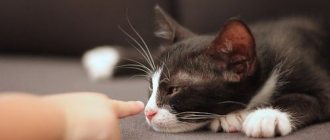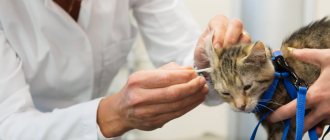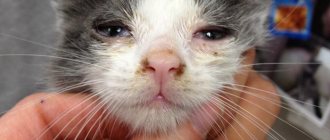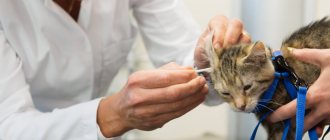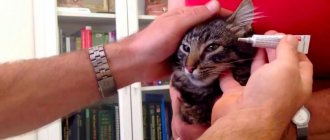Calcivirosis in cats is a contagious respiratory disease that causes inflammatory changes in the upper respiratory tract, conjunctiva of the eyes and oral cavity. Pathogen is a ribonucleic acid that includes a microbe (genus Vesivirus) from the genus Caliciviridae. An infectious scout does not contain a personal shell, has the ability to reproduce inside a cell, and causes the appearance of a special virus of neutralizing antibodies.
In 1957, the South American virologist Foster was the first to identify and describe the virus. The microbe is not stable in the external environment, in conditions of moderate moisture it retains pathogenic qualities for up to 10 days, in dry soil - no more than 2 days, is sensitive to high temperatures (it dies within 30 minutes at temperatures above 50 degrees), methanol and bleach solution. Does not lose its energy when exposed to acidic environments, chloroform, ether.
Susceptibility
Content
The disease is known in many countries of the world. Cats of all age groups and breeds are susceptible to calcivirus. Greater susceptibility to infection is observed in kittens up to three months. For them it is acute, quite intense, and quickly leads to death. Mature cats are characterized by the transition of diseases to the chronic stage.
The causes of the risk are considered to be reduced immunity as a result of other, recently suffered diseases, and incorrect vaccination or its inaccessibility.
In closed households, calcivirosis occurs in cats quite rarely. The incidence of disease between animals kept in kennels is much higher. The maximum circulation of the infectious agent is recorded in autumn and winter.
How to make sure that your cat remains a carrier of calicivirus
In 15% of cases, the disease becomes chronic ; the presence of infection is manifested by persistent inflammation of the oral mucosa and gums. Treatment gives short-term results, but soon the disease develops again, leading to tooth loss even in young animals.
Since there is no medicine that acts on the virus, animals are recommended to be treated with interferons : Reaferon and Roncoleukin.
The drugs have immunomodulatory and antiviral effects; they are used once a quarter to prevent kidney damage.
Mechanism of disease development
Reproduction of bacteria begins in the cytoplasm of cells of the mucous membrane, upper respiratory tract, conjunctiva, which leads to their degeneration and death. In the spaces where the virus is introduced, groups of bubbles with colorless contents are created. When lightly pressed, the membrane of the liquid formations collapses, revealing bleeding ulcers.
The infected contents of the vesicles, falling on other parts of the mucosa, cause the appearance of fresh lesions. The causative agent of calcivirosis can affect lung and kidney tissue.
The incubation stage of calcivirosis (from the microbe entering the body to the onset of illness) ranges from a couple of days to 20 days.
Prevention measures
Prevention of calcivirosis includes compliance with the following measures:
- annual vaccination of the animal, which reduces the risk of infection;
- systematic thorough cleaning and disinfection of the room where the pet is located;
- providing the animal with the necessary vitamins and minerals with food or as supplements, which will increase the body’s resistance to various infections;
- regular examination of the kittens’ oral cavity for the presence of ulcers and wounds, because this is the first symptom of the development of the disease.
Taking preventative measures to prevent a disease is easier than spending time and effort to treat it. Timely vaccination will avoid the development of the disease or help the animal to tolerate it in a mild form.
All information posted on the site is provided in accordance with the User Agreement and is not a direct instruction to action. We strongly recommend that before using any product, you must obtain a face-to-face consultation at an accredited veterinary clinic.
Symptoms and signs
There are acute and chronic forms of the disease.
Acute form
The initial signs and symptoms of calcivirosis in cats are determined by malaise, refusal to eat, sneezing, and an increase in temperature. Animals experience conjunctivitis, discharge from the eyes and nose, and increased salivation. Ulcers form in the mouth, nasal passages, and tip of the nose.
With an uncomplicated course of the disease and timely treatment, the disease goes away in a few weeks.
A common complication of calcivirosis is pneumonia. The disease is accompanied by fever, deep, painful, wet cough, shortness of breath, and increased heart rate. Some cats have inflamed joints and swollen limbs. Due to severe pain, animals begin to limp or completely refuse to walk. Penetration of the virus into the central nervous system is accompanied by convulsions.
Chronic form
Chronic calcivirosis is more common in mature cats. During the period of relative remission, decreased appetite, lethargy, high temperature, rapid fatigue, and unstable stool are noted.
Sick cats are considered virus carriers for a long time and constantly release the virus into the environment. The result is unfavorable; the infection leads to complete dehydration and death.
Possible complications
In most cases, calcivirosis is complicated by a bacterial infection. The probability of death increases to 60%. Other complications of feline calcivirus infection:
- pneumonia;
- dehydration;
- tooth loss due to gum inflammation;
- renal failure in chronic course.
Features of the course of the disease in kittens
Calcivirosis in kittens under three months of age occurs instantly and has an extremely complex course. The infectious process is characterized by severe catarrhal symptoms and frequent development of complications (bronchitis, pneumonia, purulent conjunctivitis). Severe swelling of the oral mucosa, pain caused by ulcers on the tongue, hard and loose palate, lead to difficulty sucking and swallowing, and a complete refusal to eat and drink. The kitten quickly becomes dehydrated, loses weight, and dies a couple of days after the onset of the disease.
Symptoms of the disease
The onset of calcivirosis occurs suddenly, accompanied by a sharp deterioration in the condition of adult and young cats. Emergency veterinary care is required if the following symptoms of infection are present:
- a sharp decrease in body weight due to deterioration of appetite or complete refusal of the offered food;
- inflammation of the eyeballs, which is similar to acute serous conjunctivitis, but occurs without keratitis and the appearance of ulcerative layers on the cornea;
- hyperthermia, accompanied by a rise in temperature to 40 degrees Celsius, as evidenced by dryness of the outer surface of the nose and shortness of breath;
- partial or complete damage to the intestines, as a result of which the process of emptying is difficult, but without the appearance of diarrhea;
- acute painful lameness caused by internal inflammation of the joint ligaments, and partial loss of orientation in space, aggravated by partial loss of auditory and olfactory qualities;
- the presence of ulcerative rashes that can be found on the hard palate, tongue muscle, tip of the nose and in the area around the claws.
If the pet is immobilized due to the onset of anorexia, then it is necessary to call a veterinarian at home . The doctor will carry out the necessary measures for an emergency examination of the cat, after which he will administer an antipyretic drug and will accompany the animal for subsequent hospitalization.
Diagnostics
When determining the diagnosis, the presence of contact with a sick animal, the characteristics of the onset of the disease, and the pet’s health status before the first manifestations of the disease are taken into account. The veterinarian conducts an in-depth medical examination, assesses the general condition of the animal, the functioning of various organs and systems. A general and biochemical blood test and urine test are taken. The data obtained is sufficient to identify a preliminary diagnosis.
The final diagnosis is determined only after identification of the pathogen. To diagnose an infection, the PCR method is used (detects the presence of an antigen in the blood, eye, and nasal fluid), and the immunofluorescence reaction (RIF) is the determination of specific antibodies in the blood serum.
The method of paired serums is very informative. In this case, blood sampling for research is carried out at the onset of the disease and after 14 days. An increase in the titer (quantity) of antibodies indicates an acute course of the disease. If wheezing appears in the lungs, a chest x-ray is taken.
In the most difficult situations, a biological test and post-mortem examination of the organs is done.
Pathogen
The causative agent of the disease is Feline Calicivirus (FCV), its symptoms resemble the human influenza virus.
Cats that have suffered from calicivirus receive immunity from it for life. However, this virus mutates and then newly emerging strains can attack the body of an already ill cat more than once.
This is interesting! Currently, scientists know more than 40 varieties of FCV.
Feline calicivirus is resistant to disinfectants, changes in pH and temperature, but is afraid of bleach solution. Outside the body of a sick animal at room temperature, it can live for about 2 weeks, and at negative temperatures - about 1 month.
Treatment
Only a veterinarian knows how to treat calcivirosis in cats. Without experience and medical education, it is not recommended to make decisions in such matters - this can lead to serious complications and death of the pet.
How long calcivirosis is treated depends on the age of the cat, the state of the immune system, and the presence of concomitant pathologies. The course of therapy for mild cases of the disease is designed for 1-2 weeks, in the presence of complications - for 3-4 weeks. Treatment when the process enters the chronic stage can last for months.
Caring for a sick animal
The treatment regimen is selected by a veterinarian.
The sick cat is isolated and the living conditions are improved as much as possible. They provide food with a balanced composition and a soft consistency, since the animal experiences pain when chewing.
A special diet is not required, but the food must be high in calories. Fasting during calicivirus is dangerous, so it is recommended to offer attractive food. If the animal does not eat on its own, the food is forcibly administered with a syringe, calculating the dose based on the daily weight requirement.
Treatment of calcivirosis
The complex of drugs is selected taking into account all the existing symptoms and the general condition of the sick animal. The usual treatment regimen for calcivirosis in cats at home includes:
- Administration of polyvalent immunoglobulins (Globfel-4, Vitafel-C) containing antibodies to calcivirosis, chlamydia and infectious rhinotrachea and hyperimmune sera according to the regimen prescribed by the veterinarian.
- Subcutaneous or intramuscular injections of immunomodulators.
- Intramuscular administration of antibacterial drugs.
- Antihistamines, multivitamins.
- Treating the oral cavity with antiseptic solutions 3 times a day.
- Rinse the eyes and clean the nose from crusts 3 times a day with special means, followed by instilling 2 drops of a medicine prescribed by a doctor into each eye or nostril.
- Balanced diet.
- Creating comfortable living conditions, proper care.
Such infectious and allergic consequences of calcivirosis in cats, such as glomerulonephritis and polyarthritis, are difficult to treat and require monitoring over time.
Calcivirosis is most difficult in kittens. Then therapy must be carried out promptly. In addition to specific, antibacterial and symptomatic agents, kittens are prescribed liquid drips.
How to treat calicivirus
Calcivirosis on the nose and eyes
No specific drugs have been developed against calicivirus ; treatment uses methods aimed at eliminating the symptoms of the disease, as well as at preventing and treating secondary inflammations that develop as a result of the addition of pathogenic microflora.
What medications does the veterinarian prescribe?
- Antiviral agents. Vitafel serum, Anandin or Fosprenil injections are used.
- Antibiotics . Indicated to prevent the development of secondary (secondary) infection, they include medications with a wide range of effects on microorganisms (Flemoxin, Azithromycin, cephalosporins).
- Immunostimulants . Required to activate the immune response (Immunofan).
- Immunomodulators . For persistent ulcerative lesions (Cycloferon).
- Antiseptics . Solutions of Furacilin, Miramistin or Vinilin are used to treat ulcers on the nose and oral mucosa.
- Eye drops and ointments. For eye inflammation, use Tobrex, Bars drops, and tetracycline ointment.
- Anti-inflammatory drugs . Medicines are recommended for arthritis (Ketofen, Loxicom).
To prevent dehydration and to restore the animal's strength, solutions of glucose, Ringer-Locke, Catozal or Gamavit, as well as vitamins C and B are administered.
Be sure to read:
Herpes in cats: symptoms and treatment, modes of transmission, folk and medications
What drugs for calicivirus can be combined
Various medications are used to treat the disease; a competent combination of drugs ensures the cat’s recovery.
How the drugs are combined:
- Systemic antibacterial agents (Fosprenil) are combined with drugs that regulate local immunity (Maksidin).
- Lozeval is prescribed internally, and the immunomodulator Maxidin or an antimicrobial solution (Miramistin, Tsiprovet) is applied to the ulcers.
- Fosprenil injections are used in parallel with local antimicrobial medications (Tsiprovet drops)
- The drug Tsiprovet can be given to a cat simultaneously in the form of tablets and the solution applied to the affected mucous membrane; sometimes the liquid product is replaced with Maxidin.
If the pet does not eat, additional droppers with infusion solutions are prescribed.
Important! The treatment regimen is selected by the veterinarian, taking into account the severity of the disease.
Danger to humans
The infection is not dangerous for people. However, regardless of whether feline calcivirosis is dangerous for humans or not, if the disease is detected in a pet, it is necessary to consult a veterinarian. Only he will be able to identify an accurate diagnosis and determine the likelihood of infection in each specific case.
When caring for an animal with calcivirus, it is necessary to observe the rules of personal hygiene (use special clothing, gloves, disinfectants), and carry out routine disinfection of the premises.
Routes of infection
A cat can catch calcivirus while walking: a sick animal sneezes towards a healthy one (the radius of the lesion is up to one meter), the pet can smell the feces of a sick animal or lie in the grass where the carrier’s excretions remain.
If the virus gets on the owner's skin, clothes or shoes, it also poses a danger to cats who do not leave the apartment. If you were visiting where the cat was already sick, you can still bring the virus into your home from it, because this cat remains a virus carrier for several more months.
After visiting cat shows, observe your pet for a few days. There may be cats with calcivirosis, or they may be its carrier, and in the first days the disease does not manifest itself.

